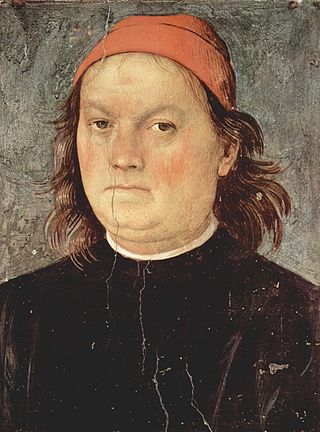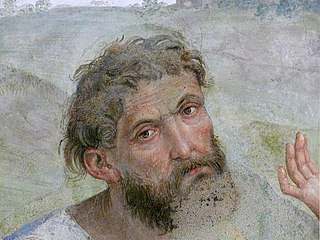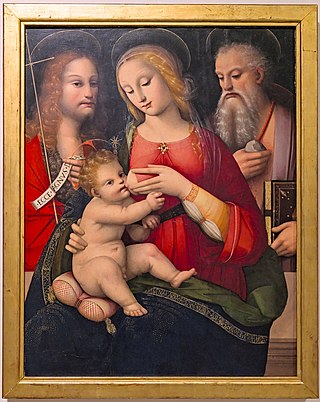
Perugia is the capital city of Umbria in central Italy, crossed by the River Tiber. The city is located about 164 km (102 mi) north of Rome and 148 km (92 mi) southeast of Florence. It covers a high hilltop and part of the valleys around the area.

Il Sodoma was the name given to the Italian Renaissance painter Giovanni Antonio Bazzi. Il Sodoma painted in a manner that superimposed the High Renaissance style of early 16th-century Rome onto the traditions of the provincial Sienese school; he spent the bulk of his professional life in Siena, with two periods in Rome.

Pinturicchio, or Pintoricchio, also known as Benetto di Biagio or Sordicchio, was an Italian Renaissance painter. He acquired his nickname because of his small stature and he used it to sign some of his artworks that were created during the fifteenth and sixteenth centuries.

Pietro Perugino, an Italian Renaissance painter of the Umbrian school, developed some of the qualities that found classic expression in the High Renaissance. Raphael became his most famous pupil.

Lo Spagna, "the Spaniard" in Italian, was a painter of the High Renaissance, active in central Italy. His name was Giovanni di Pietro, but he was known as Lo Spagna because he was born in Spain. After Raphael, he was a main pupil and follower of the Umbrian painter Perugino, whose style his paintings developed. He should not be confused with Pietro di Giovanni D'Ambrogio of Siena.

Galeazzo Campi was an Italian painter of the Renaissance from Cremona in Lombardy. He was a pupil of Boccaccio Boccaccini. His representation was rather rigid, but careful. His landscapes show influences of Perugino and Giovanni Bellini.

The collections of the Pinacoteca Comunale di Cesena, in Cesena, Italy, contain works by:

Jacopo Bertucci was an Italian painter of the Renaissance period. He is also known as Jacopone da Faenza. He was born in Faenza, and worked under Raphael in Rome. One of his pupils was Taddeo Zuccari. He was active c. 1530 and painted in the manner of Raphael. He painted for the church of San Vitale at Ravenna.

Biagio d’Antonio Tucci was an Italian Renaissance painter active in Florence, Faenza and Rome.

Andrea Busati di Stefano was an Italian painter of Albanian origin during the Renaissance period. Andrea was the son of Stefano Busati who had fled to Venice from Albania. He was a follower of the Giovanni Bellini, is the author of a signed St. Mark enthroned between SS. Francis and Andrew, painted about 1510, and now in the Gallerie dell'Accademia in Venice. A figure of a Saint in the Vicenza Gallery is also ascribed to him.

Giovanni Battista Caporali was an Italian painter of the Renaissance.
Giovanni Battista della Marca (1532–1587) was an Italian painter of the Renaissance period.

Bernardino Fungai was an Italian painter whose work marks the transition from late Gothic painting to the early Renaissance in the Sienese school. He maintained a fairly archaic style in his works, which are mainly of a devotional nature.

Andrea di Aloigi, called L'Ingegno, was an Italian Renaissance painter.

The Bufalini Chapel is a side chapel of the church of Santa Maria in Aracoeli, Rome, Italy. The first chapel on the right after the entrance, it houses a cycle of frescoes executed c. 1484-1486 by Pinturicchio depicting the life of the Franciscan friar St. Bernardino of Siena, sainted in 1450.

Andrea del Brescianino or Dei Piccinelli was an Italian painter of the Renaissance period, active mainly in Siena. Together with his brother Raffaello they were known as the Brescianini of Siena.

Stefano Orlandi was an Italian painter, active mainly in Bologna in the architectural perspective painting. He is known for painting fanciful architectural canvases, known as Capricci.
Giovanni Battista Sighicelli was a Roman Catholic prelate who served as Bishop of Faenza (1562–1575).
Miracles of Saint Bernardino is a series of eight paintings in tempera on panel showing miracles associated with Bernardino of Siena. They date to 1473 and are now in the Galleria Nazionale dell'Umbria in Perugia.
















